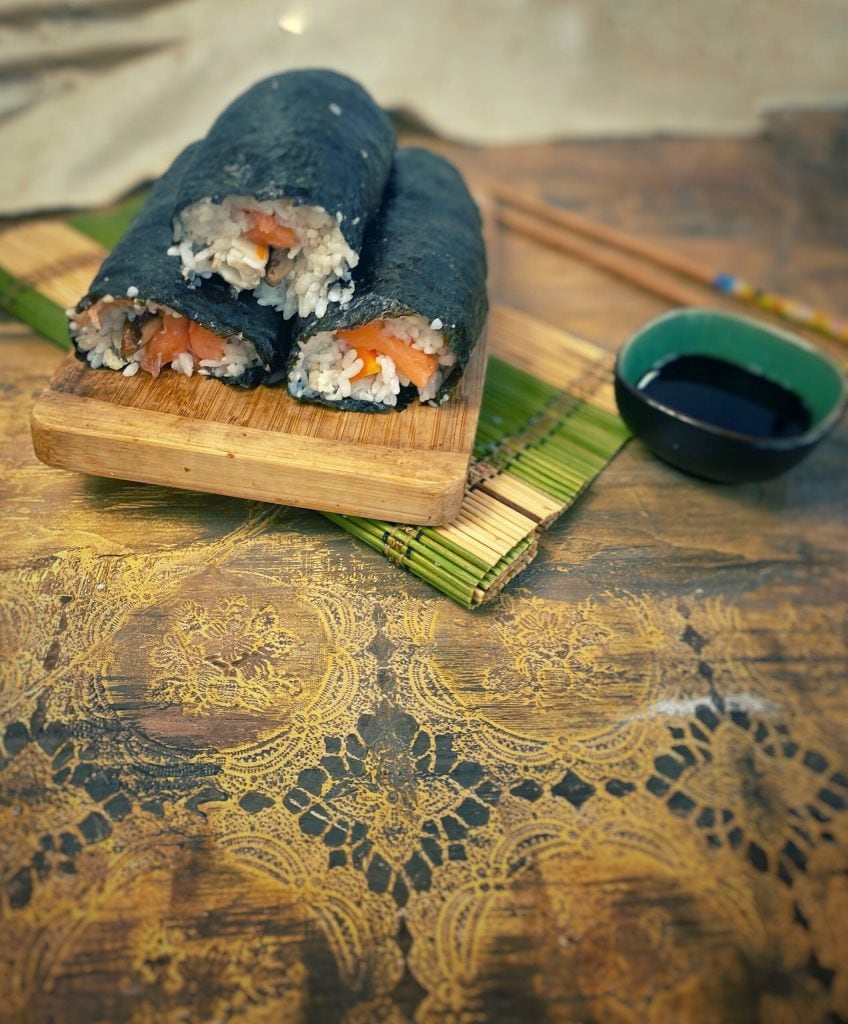The Ehomaki 恵方巻き are “thick uncut sushi rolls” said to bring good luck if eaten facing the eho (lucky direction) on Setsubun, the day before the start of each season.
It is believed that the direction depends on the position of “Toshitokujin” (歳徳神) or “The God of the New Year.”
The word “eho” (恵方) means “lucky direction” and “maki” (巻き) means to roll.
In the Kansai region, there is a unique food culture and a custom where if you eat a thick sushi roll (also called “marukaburi” or “marukaburi sushi”) while facing the lucky direction and fill your mouth silently, your wish will come true.
It is said that seven types of ingredients are used for ehomaki. The number is associated with the seven lucky gods, who pray for prosperous business and good health, and it is said to bring good fortune.
There are no specific seven types of ingredients, but the following are typical examples:
• Koya-tofu (frozen tofu)
• Kanpyo (dried gourd)
• Cucumber (kaiware)
• Datemaki (Dashimaki/Atsuyaki tamago/tamagoyaki)
• Eel (conger)
• Sakura Denbu (boiled white fish/Oboro)
• Boiled shiitake mushrooms
Additionally, from the Taisho period to the early Showa period, pickles were often mentioned.
Other ingredients that may be used include grilled red salmon, kamaboko (crab-flavored), shiso (perilla leaves), mitsuba (spinach), ginger, rapeseed flowers, and carrots.
Since the 2000s, salmon, salmon roe, squid, shrimp, tuna (negitoro, pickled tuna), etc., have been used and sometimes sold in stores under the name “kaisen ehomaki.”
On the blog, you can find other types of sushi:

- Difficulty: Difficult
- Cost: Economical
- Preparation time: 10 Minutes
- Portions: 3 Pieces
- Cooking methods: No cooking
- Cuisine: Japanese
- Seasonality: All seasons
Ingredients
- 1 1/2 cups gohan rice
- 3 nori seaweed
- 2 tablespoons rice vinegar
- 1/2 teaspoon sugar
- 1 teaspoon salt
Steps
Prepare the gohan rice, following this recipe. Season with rice vinegar, sugar, and salt while it’s still warm.
Place the nori seaweed with the rough side up and the shiny side down.
Add the rice to the top part and then spread it out. Add the fillings in a row in the center, one on top of the other.
With the help of a sushi mat roll it up.
Do not cut.

FAQ
Why are beans thrown during Setsubun?
When translating “Setsubun” into English, it is often called the “Bean Throwing Festival.”
The name comes from the tradition of throwing roasted soybeans outside the front door or at a family member wearing a demon mask to drive away evil spirits.
This is not only done at home but also at local shrines or temples.
Besides eating ehomaki, it is considered lucky to eat 1 roasted soybean for each year of your life, plus one more for the coming year.How is the lucky position (eho) determined to face when eating ehomaki?
The direction of Toshitokujin (i.e., the lucky direction)
is determined as follows depending on the Judan of the year.
It is decided by the Chinese counting system: 10 heavenly stems and 12 earthly branches, the most important counting systems in the Chinese (lunar) calendar.
This system also decides the Chinese zodiac of each year, the yin/yang, the element, etc.)What is the difference between Ehomaki and Sushi burrito?
The difference lies in the filling.
The sushi burrito includes fillings akin to Mexican and Tex-Mex cuisine, preferably spreadable (like avocado or sauces or cheese) and compact (like jicama or cucumber or fish or meat).

